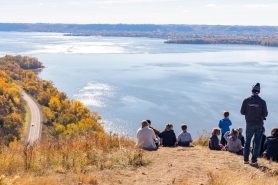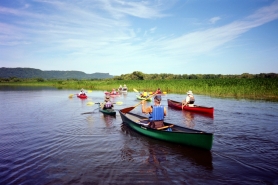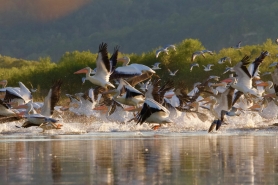Visit the Upper Mississippi River
There are a thousand ways and four different seasons to experience the natural wonders of the Mississippi River with family or friends.
Visitor favorites
- Enjoy some of the best in birding as hundreds of bald eagles gather on the river in early spring or when thousands of tundra swans rest from their autumn journey to the east coast. There are also two birding trails in the Mississippi River corridor.
- Explore the hundreds of sloughs and side channels that make up this great river by boat. Fish for walleye, bass and bluegill in the stillness of an early summer morning, or throw in a setline for a late evening of catfishing. Winter offers an escape for hardy anglers who enjoy ice fishing. Check the Fishing and Boating on the Mississippi River Guide for pool maps and fishing advice.
- Explore the Wisconsin DNR webpage and mapping application, Boat and Shore Fishing Access, for an interactive state map to locate public boat access sites and shore fishing sites. Once in the mapping application, zoom in along the Mississippi River to specific areas of interest.
- For large open water areas on the Mississippi River such as Lake Pepin, Lake Onalaska, and Wigwam Slough – the DNR Find a Lake webpage also has search tools to find public boat landings, fishing, public lands and parks.
- Travel on the wild side - explore the quiet backwaters by canoe or kayak as these areas are generally the best places to spot wildlife. There are marked canoe trails through the backwaters.
- Scenic vistas from the bluff tops reward the hiker on many a trail in the state parks, natural areas and wildlife areas along the river.
- Pedal your way along an old rail bed through the Mississippi River bottoms and catch a glimpse of cardinal flowers that literally seem to glow in the cool shadows of the bottomland forest.
- Take advantage of the many overlooks along Wisconsin's Great River Road Scenic Byway that borders this stretch of the Mississippi River. Explore the scenic river towns as well.
Wisconsin's Great River Road
The Wisconsin Great River Road is Wisconsin’s only designated National Scenic Byway. Traveling 250 miles along the Mississippi River and through more than 33 historic river towns and villages, it links resources, people and history.
The communities along the Wisconsin Great River Road are among the oldest in the Midwest, with some communities dating to the 1600s. Before European settlement, Native American tribes called the river corridor home. Today, visitors will see remnants of the Oneota, Hopewell and other ancient cultures through the burial mounds and effigy mounds found up and down the Wisconsin Great River Road.
The miles of wetlands and untouched river-bottom forests that run along more than two thirds of the Wisconsin Great River Road are a result of an Act of Congress in 1924 that established the Upper Mississippi River National Wildlife Refuge. The beautiful pools and winding channels that you see on the Mississippi River today are a result of the Lock and Dam system built in the 1930s.
The 250-mile Wisconsin Great River Road is part of the ten-state Great River Road National Scenic Byway, which follows the Mississippi River for 3,000 miles through ten states, from northern Minnesota to the Gulf of Mexico. Established in 1938 by Franklin Roosevelt, the Great River Road is America’s oldest and most distinguished byway.
Parks, trails and campgrounds
State bike trails
There are two bike trails near the Mississippi River, the Great River State Trail and the La Crosse River State Trail, which offer a delightful journey on old rail beds.
Canoe trails
The Mississippi River backwaters, which are more protected from the current and commercial navigation, offer opportunities for canoeing and kayaking. In Wisconsin, there are marked canoe trails at Merrick, Perrot and Wyalusing State Parks and on the Upper Mississippi River National Wildlife and Fish Refuge.
The Refuge Water Trails located in Wisconsin were developed in partnership with the Wisconsin DNR and include:
- Goose Island Canoe Trail. From La Crosse, take Highway 35 South to county Highway GI (west), the road into Goose Island County Park. The trail can be accessed from any of the three boat ramps in Goose Island County Park.
- Long Lake Canoe Trail. From Highway 35 in Trempealeau, go south on Fremont Street (Lake Road), continue past the railroad tracks for 1.5 miles. The Long Lake Boat Landing marks the beginning and end of the canoe trail.
Brochures for canoe trails located in the refuge are available at Upper Mississippi River National Wildlife and Fish Refuge - follow the link to trails.
They are locally available at the trailheads, the Wisconsin DNR La Crosse Service Center or the La Crosse District Headquarters of the Upper Mississippi River Refuge.
Birding trails
Currently there are two birding trails that include the Mississippi River corridor.
- The Great Wisconsin Birding and Nature Trail - Mississippi/Chippewa Rivers Region is a mapped auto trail that covers 13 of Wisconsin's western counties. Full-color viewing guides are available that include maps and descriptions of every site as well as a description of the property and common and rare birds and wildlife. Hard copies of the guide are available at the Wisconsin DNR - La Crosse Service Center or can be ordered online, by phone (800-432-TRIP) or at Wisconsin Travel Information Centers.
- The Audubon Great River Birding Trail is a self-guided tour which parallels both sides of the Mississippi River. The trail guide lists birding sites that are along or close to the Great River Road such as parks, overlooks, wildlife refuges, wildlife management areas. Maps, site descriptions, facilities and more are provided along with birding tips.
State natural areas
Discover Wisconsin's hidden treasures! There are many, little known sites along the river that are designated as State Natural Areas. Several offer hiking trails and scenic vistas of the Mississippi River. Whitman Bottoms Floodplain Forest near Merrick State Park also has a canoe landing. Follow the links to locate them, find out more about the sites and check regulations. These areas have been set aside to preserve outstanding and relatively undisturbed tracts of Wisconsin's native landscapes.
State wildlife areas
Five Wisconsin State Wildlife Areas are located on or near the Mississippi River. They are excellent places to hunt, fish, hike, canoe or watch wildlife.
- McGilvray Bridges and Van Loon State Wildlife Area - This 4,000-acre wildlife area is located near Trempealeau includes a hiking trail that follows an old road through the bottomlands of the Black River. The trail includes six historic McGilvray arch truss bridges over the Black River built circa 1892.
- The Pierce County Islands Wildlife Area is located 1 mile west of Bay City on Mississippi River. Located between Hwy. 63 and Bay City. Access by river.
- Trempealeau Lakes State Wildlife Area - This wildlife area is only 164 acres in size. The lakes are separated from the Mississippi River by marshes and are ringed with floodplain forests. Canoe, fish or hike. From Trempealeau, take Hwy 35 one mile west toward Lock and Dam 6. Cross the railroad tracks and turn left 1 mile to the entrance.
- Whitman Dam State Wildlife Area - This 2,173-acre wildlife area comprised of six miles of marsh and slough from Merrick Park north to the village of Buffalo.
- Tiffany Bottoms State Wildlife Area - This 13,000-acre wildlife area includes property on both sides of the Chippewa River between Durand and the confluence of the Chippewa with the Mississippi River at Nelson. The area offers an abundance of bird viewing opportunities as it is considered critical habitat for many of Wisconsin's breeding birds. You can hike along the 8 miles of railroad track or take a ride in an antique open-air train into the Tiffany Bottoms.
Links to other public lands and facilities
Effigy Mounds National Monument
Prehistoric mounds built by Native Americans are relatively common, but only in this general area was there a Woodland Indian culture that regularly constructed mounds in the shape of mammals, birds or reptiles. There are also 11 miles of hiking trails at the National Monument which is located just across the river from Prairie du Chien, Wisconsin.
Upper Mississippi River National Wildlife and Fish Refuge
The refuge, which encompasses acres of wooded islands and backwaters, begins at the mouth of the Chippewa River and extends 261 miles downstream, nearly to Rock Island, Illinois. The refuge is administered by the U.S. Fish and Wildlife Service. The popularity of a variety of recreation activities has made this the most heavily used refuge in the nation. Check their website for information, maps and regulations governing public use.
Trempealeau National Wildlife Refuge
This 6,220-acre refuge is an isolated backwater cut off from the Mississippi and Trempealeau Rivers by dikes. The backwater marshes provide resting and feeding areas for waterfowl and other water birds. The refuge with its rolling topography offers fishing and wildlife watching and is also accessible from the Great River State Bike Trail.
National Mississippi River Museum and Aquarium
Get to know the Mississippi through an interactive experience of being a barge pilot or enjoy a stroll through a Mississippi River wetland. The museum, located in Dubuque, Iowa also offers aquariums with river creatures and historical exhibits.




